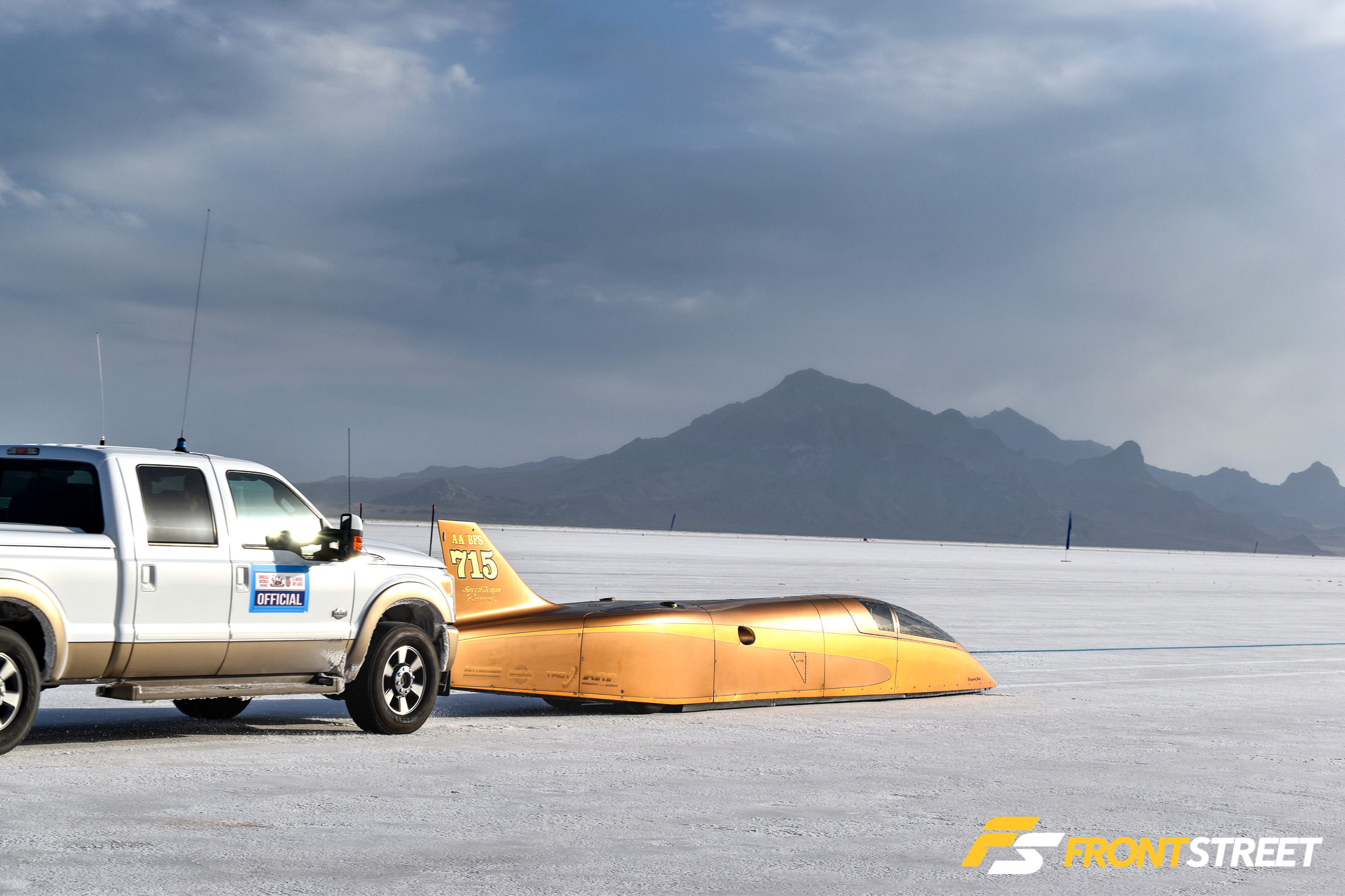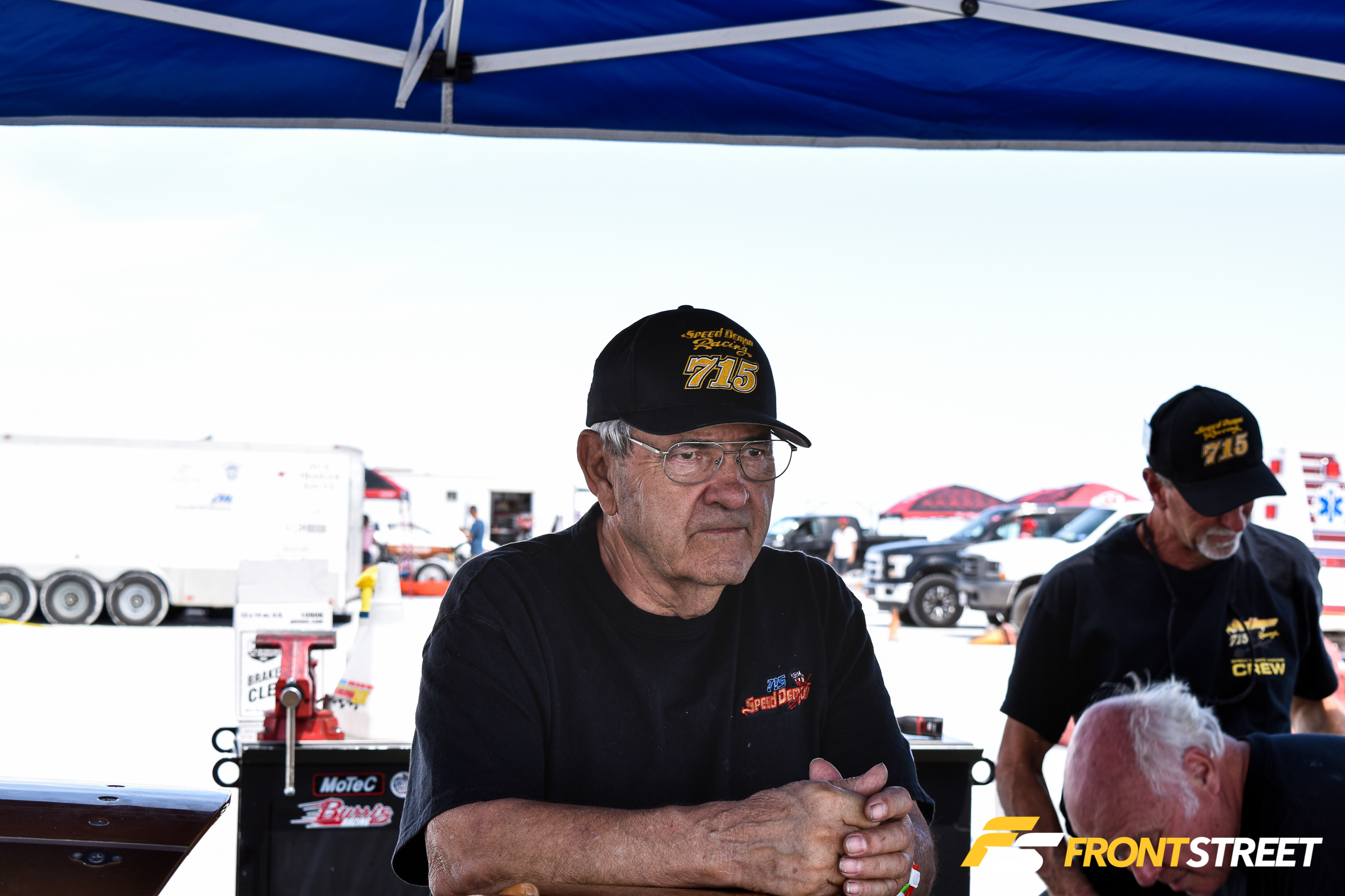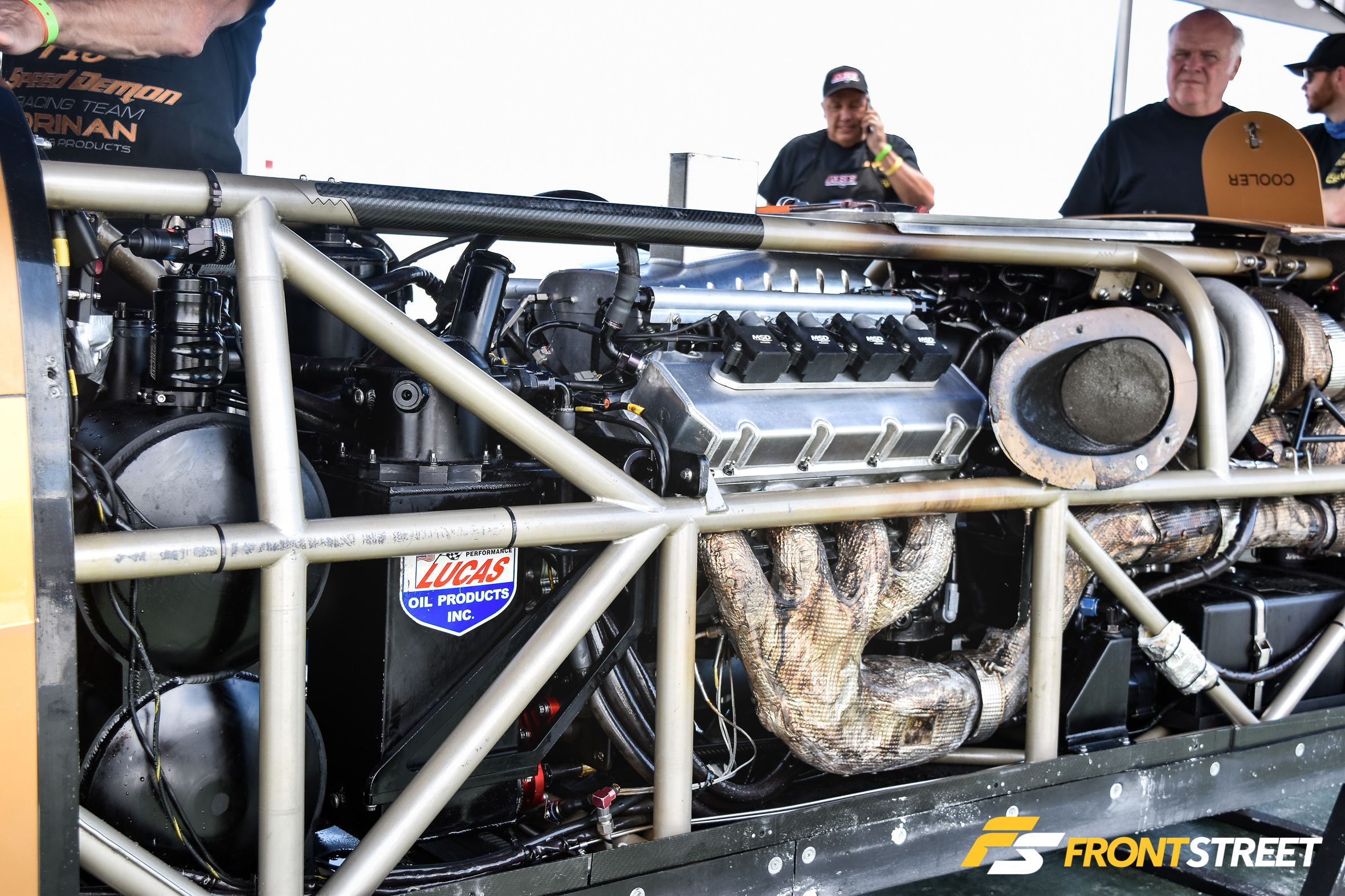George Poteet’s Speed Demon streamliner is officially the world’s fastest wheel-driven, piston-powered vehicle by a considerable margin, establishing a new Southern California Timing Association (SCTA) record of 470.016 mph with an official terminal speed of 481.576 mph at the end of the timed mile. This is faster than the previous record established by Danny Thompson’s Challenger 2 at 448.757 mph in 2018. And while not officially recognized by the FIA world record authority, it is considerably faster than the current FIA 458.440 mph world land speed record set in 2001 by Don Vesco’s Turbinator — a turbine-powered, wheel-driven car.
The Speed Demon is unique. It is a single-engine car driven only by the rear wheels in a venue where conventional wisdom insists that multiple engines and four-wheel-drive are essential to achieving peak speed levels. It has four wheels with the two front wheels aligned in tandem, which is also considered to be inherently unstable compared to front steering and driven wheels that ride beside each other. The Speed Demon has encountered no difficulty running in its own configuration and is currently faster than all the other competitors.


The Speed Demon owns virtually the whole upper half of the record ladder for the SCTA’s Unlimited Blown Fuel Streamliner class, using various displacement engines to fit different classes. For 2020, the team came with four different bullets in its piston-powered arsenal, all twin-turbocharged engines running on methanol. The primary engine for this effort is a 557 ci Dart-based big-block sporting upwards of 3,200 horsepower. This engine’s goal was to set a record above 450 mph, which would also secure the Hot Rod Magazine Top Speed of the meet trophy for the ninth time. The AA/BFS (Blown Fuel Streamliner) record stood at 417 mph, and the team felt that they could raise it to more than 450 mph.
It’s axiomatic that the best-laid plans often breed success, but not without a few hiccups along the way. After an initial checkout pass at 380 mph to verify systems, Poteet’s second pass at 411 mph came up short of Tom Burkland’s 417.020 mph record, set in 2004. After a brief tuning session back in the pits, George made a third run resulting in an encouraging 447 mph average in the fifth mile and a 455 mph exit speed. Unfortunately, an oil-based engine fire occurred, burning up some of the wiring. A backup pass for the record seemed improbable at this time. After downloading the data, the team decided to forego the usual trip to impound for record qualifiers.



The big-block engine was removed, and team members began readying the 442-cid LS-based A-class engine. When the data indicated that the number four cylinder had leaned out considerably, team members converged to pull the big-block’s cylinder head. The number four piston had a gaping hole in the center of it from the lean condition. When the piston holed, it pressurized the sump causing the valve cover gaskets to fail and spray down the hot engine bay, hence the minor but smokey engine fire.
It was quickly determined that the cylinder was not damaged. A replacement piston was fitted by team members Chris Raschke, Charles Jenckes, and John Baechtel working feverishly with the engine upended on the floor of the trailer. A few small scratches were quickly cleaned up by four or five strokes with a ball hone, and a new set of file fit rings was installed. The field repair was successful. By the end of the day, the LS engine was pushed aside in favor of reinstalling the repaired big-block. The data indicated an overall lean condition on the fuel map with something causing a severe lean issue specifically in the failed cylinder. After test flowing the injectors, it was felt that a manifold issue might be the problem. So, the number four cylinder was programmed for fifteen percent greater enrichment than the rest.





Wiring guru, Greg Pyles, labored overnight to repair the wiring system. Several sensors were replaced, as were several burned solenoids on the air-shifted Liberty transmission. The body insulation was also fixed, and the car was ready to run by mid-day Sunday. Hopes were high since it had run 455 mph on only seven cylinders. The fourth run ended in disappointment when the pinion shaft in the rear end gave up the ghost. Fortunately, the team had a spare, and they were able to quickly effect a repair and get back in line for the car’s fifth pass of the meet. Another issue with a failed boost regulator on that run caused them to make further adjustments and get back in line for a sixth run.
Late Monday afternoon, they qualified for the AA/BFS record with a speed of 428.182 mph. Tuesday morning, they finally set the new record to 439.246 mph based on a 450.311 fifth mile average combined with the previous day’s qualifying speed. Still, Poteet and the team were not satisfied. The engine builder, Kenny Duttweiler, knew there was plenty of speed left in the combination. George wanted to set a record well over 450 mph to reclaim the title of the fastest piston-powered car. That title was held by Danny Thompson, who drove the Challenger II AA Fuel Streamliner to a 448.757 mph record in 2018.
Finally, on Wednesday afternoon, all the planets aligned. George streaked to a 469.298 mph average through the fifth mile, qualifying to raise the record even higher. Thursday morning, he astounded onlookers with a 481.576 mph exit speed netting a 470.733 mph average and resetting the AA/BFS record to 470.016 mph. It was a staggering achievement for a rear-wheel-driven piston-powered car and one that served notice of even greater potential.
With little time remaining, the team quickly swapped the big-block out for a 256-cid twin-turbo small-block to attach the E-class record of 348.150 mph, the only one that George does not yet own. Unfortunately, an oil pressure light came on, and George aborted the run. The team was unable to pinpoint the cause before the end of the day. The meet was coming to an end, so they packed up and headed home, snug in the knowledge that no other piston-powered car was anywhere close to the blistering speeds they recorded with the big-block engine.
George Poteet has the wherewithal to pay his own way for these records. Still, he is quick to credit the extraordinary team effort and the individual contributions by every team member. Affectionately now known as “The Men in Black,” they are the backbone of a successful effort. Additional support comes from Automotive Racing Products (ARP), the official supplier of all fasteners on the car, and Lucas Oil Products, Inc. that provide all the essential lubricants.




The crew chief and primary car builder is Steve Watt of Maxwell Industries. The engine builder is Kenny Duttweiler of Duttweiler Performance, and tuning is performed by Shane Tecklenburg. In addition to Poteet’s remarkable string of records, each of them can now claim the unofficial title of the world’s fastest car builder, world’s fastest engine builder, and world’s fastest tuner, respectively.
The Speed Demon has consistently proved to be the fastest, most resilient traditionally powered car in land speed racing history. Whenever anyone starts to get close, the team digs deep and puts more speed on the record books. We all know that 500 mph is a steep hill to climb, but only the Speed Demon seems capable of sneaking up on it a little more every year. Only time will tell.
https://www.speeddemon715.com/
https://www.facebook.com/speeddemon715/
https://www.instagram.com/speeddemonracingteam/













